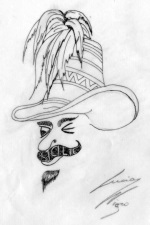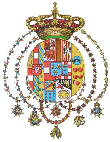
|
Se si esclude Lettera Napoletana n. 16 - maggio 2009 e un articolo di di questi giorni di Angela Pellicciari sul quotidiano Libero, che hanno rilanciato l’ipotesi dell'avvelenamento di Ferdinando II, su internet non esiste nulla in lingua italiana che affronti questo tema. Non così in lingua inglese, dove si trovano svariati documenti che riportano la tesi dell'avvelenamento. Noi in tutta sincerità non abbiamo mai condiviso certe tesi complottistiche che avevano il sapore di legittimismo di altri tempi, ma apprendere della vicenda umana di Filippo Carabi candidato all’assassinio del re nel 1856 e a sua volta assassinato nel 1861 (cinque anni dopo!!!) per essersi tirato indietro dal commettere l’attentato perché spaventato dalla potenza di una bomba-prova, ci ha un po’ fatto cambiare opinione. Forse Re Ferdinando era un ostacolo ingombrante che andava spazzato via prima possibile e fu veramente avvelenato. Il testo Occult Theocrasy Lady Queenborough - in formato pdf - si trova in rete. |
Ferdinando II - The poison was administered in a slice of melon*
Fonte:Occult Theocrasy by Lady Queenborough (Edith Starr Miller)
pag. 265
In September, 1856, the European Committee decided that the King of Naples should be assassinated and that at the same time there should be an insurrection in Sicily. A man named Baron de Bentivegna, who had been introduced by an English high mason, Henri Misley, to Mazzini in London, was entrusted with the task of fomenting the trouble, while Lemmi took charge of the murder. According to the plan, Ferdinand II was to be blown up by a bomb thrown under his car¬riage by some fanatic selected by Lemmi.
Armed with two bombs, Lemmi went to Sicily. He now travelled under a French passport, provided for him by a friend through Ledru-Rollin, and made out under the name of "Jacques Lathuile", merchant.
Everything was ready both in Palermo and Naples. The dates of the assassination of the king and the outbreak of the revolution were fixed for November 22, but the individual chosen to perform the deed, Filippo Carabi, suddenly lost interest in the project when he realized that the bomb destined for the king would also inevitably prove fatal to himself.
Lemmi was angry over this unexpected check. It was then too late to recruit another executioner but the disobedient Sicilian was eventually punished, for, five years later he was murdered in a Neapolitan lodge where he had gone without apprehension. The archives of the Directory of Naples contain the details of the affair, the sequestration of Carabi in 1861, his accusation before a secret tribunal, the terrible tortures to which he was subjected and his last horrible agony, shrouded in mystery.
Lemmi, now unable to have the assassination and the plot coincide, stayed on nevertheless in Naples, as he hoped to find a substitute for the defaulting murderer.
On the appointed day, November 22, Bentivegna raised the banner of revolt at Cefalú, near Palermo.
"Jacques Lathuile", finding himself obliged to substitute another for the bomb method of assassination, induced a soldier called Agesilas Milano to attempt the life of the king, so, while Ferdinand II was review¬ing his troops, Milano stepped forward and struck him twice in the chest with his bayonet. Luckily for the king, the instrument bent, failing even to wound him. Milano was arrested, judged and shot, but Mazzini, qualifying him as a martyr, had a commemoration medal struck in his honour.
As for the insurrection in Sicily, it was suppressed, Bentivegna was captured and shot on December 20, but Lemmi-Lathuile left the country as soon as he realized that things were not going well. His identity was never revealed and can today only be definitely established by the records of the secret masonic trial of Filippo Carabi in the archives of the Directory of Naples.
In 1857, a splendid farce was enacted by Piedmont. It has since been repeatedly proved that Cavour and Rattazzi were in agreement with the Mazzinians and the Garibaldians with regard to the scheme for a Uni¬ted Italy, under the house of Savoy — that is to say, they favoured the dispossession of the legitimate sove¬reigns of the duchies of Tuscany, Parma, Modena, the Papal States and the Kingdom of the two Sicilies, and the wresting of Lombardy and Venice from Austria. In the eyes of the European monarchs who were not in the secret, Piedmont wished to appear innocent of any connivance in the plot, and to have been forced only reluctantly to acquiesce. The secretary and faithful friend of Count Cavour was the Piedmontese
Isaac Artom, 5 while l'Olper, later rabbi of Turin and also the friend and counsellor of Mazzini, was one of the most open advocates of Italian Indepen¬dence.
[...]
pag. 271
The Piedmontese were not quite satisfied with the results of the hasty treaty of Villafranca (1859), but the revolutionaries had attained their object as far as Tuscany, the Duchies of Parma and Modena and the Pontifical States were concerned, though they did not dare to dispossess the Pope without some pre¬liminary political manoeuvres. The revolution in the kingdom of the two Sicilies had failed again but it was soon to succeed.
By way of retaliation, the International Committee of London began a propaganda in Lombardy among the students in the colleges as a result of which the University of Pavia was forced to close. This movement which started in December was the precursor of the coming war. Lord Palmerston's plan was in process of realization.
To Francesco Crispi, a tool of Lemmi, was now as¬signed the task in which he and Bentivegna had failed. He was in London when the news of the death by poison of Ferdinand II reached the International Masonic Committee. Mazzini's tool in the poison plot was Monsignor Caputo, a priest who had succeeded in winning the confidence of the king as his confessor. He was a Freemason, and a Sublime Maître Parfait, belonging to one of the most evil branches of the sect. The poison was administered in a slice of melon and the king died in agony, on May 22, 1857.
Freemasonry had won, for Francis II, who now succee¬ded his father, was too young and inexperienced to be able to cope with any serious political situation alone.
* Titolo nostro [webmaster]
| Fonte: The Secret Holocaust by Eustace Mullins Under the pretext that the King of Naples was not observing strict neutrality towards Russia, Lord Palmerston obtained the disgrace of Mazza, the Neapolitan Director of Police. In this move, he was aided by Mazzini, who, having caused certain confidential papers to be stolen, knew some things that were none of his business. Mazza, devoted to the King, had been his protector against the machinations of the secret societies. Napoleon III, too, allowed himself to be influenced by Palmerston who, as Patriarch of European Freemasonry, favored one of his pet projects. This involved the appointment of Prince Murat, Grand master of the Grand Orient of France, to the throne of Naples and the two Sicilies, and the elimination of the house of Burbon. England and France presently threatened to send a squadron to Naples but owing to the protest of Russia, the threat was never carried out. In September, 1856, the European Committee decided that the King of Naples should be assassinated and that at the same time there should be an insurrection in Sicily. A man named Baron de Bentivegna, who had been introduced by an English high mason, Henri Misley, to Mazzini in London, was entrusted with the task of fomenting the trouble, while Lemmi took charge of the murder. According to the plan, Ferdinand II was to be blown up by a bomb thrown under his carriage by some fanatic selected by Lemmi. Armed with two bombs, Lemmi went to Sicily. He now traveled under a French passport, provided for him by a friend through LedruRollin, and made out under the name of "Jacques Lathuile," merchant. Everything was ready both in Palermo and Naples. The dates of the assassination of the king and the outbreak of the revolution were fixed for November 22, but the individual chosen to perform the deed, Filippo Carabi, suddenly lost interest in the project when he realized that the bomb destined for the king would also inevitably prove fatal to himself. Lemmi was angry over this unexpected check. It was then too late to recruit another executioner but the disobedient Sicilian was eventually punished, for, five years later he was murdered in a Neapolitan lodge where he had bone without apprehension. The archives of the Directory of Naples contain the details of the affair, the sequestration of Carabi in 1861, his accusation before a secret tribunal, the terrible tortures to which he was subjected and his last horrible agony, shrouded in mystery. Lemmi, now unable to have the assassination and the plot coincide, stayed on nevertheless in Naples, as he hoped to find a substitute for the defaulting murderer. On the appointed day, November 22, Bentivegna raised the banner of revolt at Cefalu, near Palermo. Jacques Lathuile, finding himself obliged to substitute another for the bomb method of assassination, induced a soldier called Agesilas Milano to attempt the life of the king, so, while Ferdinand II was reviewing his troops, Milano stepped forward and struck him twice in the chest with his bayonet. Luckily for the king, the instrument bent, failing even to wound him. Milano was arrested, judged and shot, but Mazzini, qualifying him as a martyr, had a commemoration medal struck in his honor. As for the insurrection in Sicily, it was suppressed, Bentivegna was captured and shot on December 29, but LemmiLathuile left the country as soon as he realized that things were not going well. His identity was never revealed and can today only be definitely established by the records of the secret Masonic trial of Filippo Carabi in the archives of the Directory of Naples. |
| Fonte: Final Warning: A History of the New World Order by David Rivera, 1994 Giuseppe Mazzini (1805-72)After Weishaupt died on November 18, 1830 at the age of 82, Giuseppe Mazzini (1805-72), an Italian patriot and revolutionary leader, was appointed head of the Illuminati in 1834. It was believed that Weishaupt rejoined the Catholic Church with a deathbed repentance. While attending Genoa University, Giuseppe Mazzini became a 33rd degree Mason, and joined a secret organization known as the Carbonari (their stated goal in 1818: "Our final aim is that of Voltaire and of the French Revolution -- the complete annihilation of Catholicism, and ultimately all Christianity."), where he became committed to the cause of Italian unity. In 1831 he was exiled to France where he founded the 'Young Societies' movement which included Giovane Italia (Young Italy), Young England, etc. This group united those who wanted to achieve unification through force. Mazzini moved to England in 1837 then returned to Italy in 1848 to lead the revolution against the Austrians. Again he was exiled. In the 1850's he led more revolutionary activities, and through his actions Italy became united in 1861 as a single kingdom rather than the republic envisioned by Mazzini. Mazzini, who became known as the 'Evil Genius of Italy,' tried to carry on the activities of the Illuminati through the Alta Vendita Lodge, the highest lodge of the Carbonari. From 1814-48, the group known as the Haute Vente Romaine led the activities of most of Europe's secret societies. In April, 1836 the head of the Haute Vente, whose pseudonym was 'Nubius,' wrote to 'Beppo': "Mazzini behaves too much like a conspirator of melodrama to suit the obscure role we resign ourselves to play until our triumph. Mazzini likes to talk about a great many things, about himself above all. He never ceases writing that he is overthrowing thrones and altars, that he fertilizes the peoples, that he is the prophet of humanitarianism..." In 1860, Giuseppe Mazzini had formed an organization called the 'Oblonica,' a name derived from the Latin 'obelus', which means: "I beckon with a spit (dagger)." Within this group, he established an inner circle called the Mafia. About 1000 A.D., after the Normans had driven the Arabs out of Sicily, they established a feudal system. Overseers to guard each feudi were chosen from known criminals. Skirmishes between the Barons were fought by these criminals. Although feudal privileges were abolished in 1812, these overseers retained control of the land through leasing arrangements. It was this band of criminals that Mazzini gave the name 'Mafia', which was an acronym for Mazzini, Autorizza, Furti, Incendi, and Avvelengmenti. Known as the Mafiosi, they were authorized by Mazzini to commit thefts, arson and murder. It was this organization that came to America during the 1890's with the beginning of Italian immigration. |
Ai
sensi della legge n.62 del 7 marzo 2001 il presente sito non
costituisce testata giornalistica.
Eleaml viene aggiornato secondo la disponibilità del materiale e del Webm@ster.





